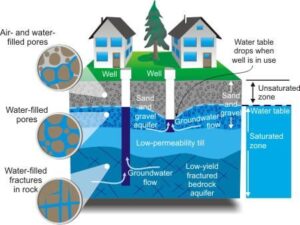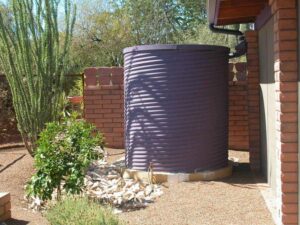What’s the Difference Between a Well and Cistern?
Most of us are familiar with water wells. We at least understand that they’re needed when we live in a remote area that doesn’t tap into a city or county water line.
Instead, a well must be installed to tap into an underground water source. The land will determine how far you must dig to reach the water table. This varies significantly from area to area.
But have you heard of a cistern? Is it a better option than a well?
Is it a sustainable and reliable source of water year-round?
Let’s go a little deeper (no pun intended). 🙂
What is a Well?
A well is a shaft or a deep hole drilled into the ground to access natural resources, such as water. For almost 8,000 years, wells have been used in several cultures worldwide. The earliest wells were presumably dug by hand or using primitive tools. They allowed groundwater extraction that could then bring water to the surface.
Rainwater is absorbed into the soil as it falls. The water drips down, watering various plants, and progresses through the layers until it reaches the water table, the boundary between the earth and the water. When the water gets to a rock, it can’t move beyond, and it comes to a stop. This produces open spaces where the water collects and forms underground pools.
A bucket can then be filled with water and pulled up with a rope by digging into one of these underground pools.
A modern-day well involves pipes, electricity, and a pressure tank that feed water into your home for running water.
What is a Cistern?
Both cisterns and wells provide water, but they work in different ways. Wells take advantage of the existing water supply in the ground and pump it to another area. On the other hand, cisterns work in the same way that a huge storage container does. While the two are different, they can work together to lower the cost and consumption of valuable well water.
Cisterns gather water from the ground and store it in a waterproof container, similar to a covered reservoir. This is perfect for collecting rainwater and storing it for later use. Cisterns designed for this purpose are often built with downspouts and gutters that direct rain into the cistern’s interior. A cistern can also collect water pumped from a well or transported by a water truck.
However, there is a challenge, as the cistern’s only way of performing its role is to have enough rainfall, or at least enough to meet the household’s needs.
Cisterns have long been used in dry areas to store water if wells fail or there is not enough rainfall. Some even now use them as a backup water supply in the case of a prolonged power outage that prevents access to a well’s contents. Without a backup power source, a well cannot function.
Conclusion
A cistern may be a viable water supply if you live in an area with adequate rainfall. Whether you use it as a backup to a well or a primary source is a decision only you can make. Cisterns and wells are very different, but they complement each other well.
If you lean to a cistern, you will also want to check with the planning and zoning in your county to verify cisterns are allowed.
➡️Don’t forget to join our VIP Program to stay informed on coming soon properties, special discounts, and early access to the new properties before we start advertising to the public!!
➡️Check out our current inventory!



